Haramachi Cultural Properties 2
12. Shihonchakushoku Nomaoi Zu (Colored Illustration of Nomaoi on Paper)
Type: Prefecture designated important tangible folk cultural property
Date Designated: March 31, 2000
Location: Minamisoma Museum – Haramachi, Gorai, Deguchi 194
Google Maps: Minamisoma Museum
Owner: Individual
This image is actually made up of two illustrations, the “Nomaoi Procession” (Nomaoi gyouretsu zu), and the “Wild Horse Capture” (nomakake zu).
The “Nomaoi Procession” portrays an army of warriors on a mountain in the background, with the procession moving in the foreground. The warriors’ expressions are similar, but their clothing, their flags, and the items each person is carrying are detailed and precisely colored.
The “Wild Horse Capture” shows the catching a wild horse the grounds of the Odaka shrine. A bamboo enclosure surrounds the ceremony site, and the encampment of a feudal lord sits in the upper right corner. In the center, youths attempt to catch the wild horse barehanded. The depiction of the youths and the appearance of the surrounding crowd express the festive atmosphere of the wild horse capturing ceremony.
Based on the clothing and chainmail worn by the members of the procession carrying feathered lances, both images are estimated to date back before 1782.

"Wild Horse Capture"

"Nomaoi Procession"
13. Soma Nomaoi Zu Byoubu (Illustration of Soma Nomaoi on Pair of Folding Screens)
Type: Prefecture designated tangible folk cultural property
Date Designated: April 26, 2016
Location: Minamisoma Museum – Haramachi, Gorai, Deguchi 194
Google Maps: Minamisoma Museum
Owner: Minamisoma City
Dimensions: Height – 1.7 meters Length – 3.46 meters
One pair of panels with six folds each
On the right panel is the gorgeous depiction of a horseback procession of feudal lords emerging from under a red canopy, entering through a wicket gate for wild horses (Haramachi gate) into the Nomahara field as a crowd of people look on. A military encampment stands at the left edge, and wild horses race in the center of the panel. In the upper right, a camp enclosure surrounding a banner, the main body of the army flying flags, and a military formation were painted in a lively fashion. A straight mountain range can be seen in the distance..
As a continuation of the scene on the right panel, the left panel depicts wild horses are being driven out of a wicket gate (Sukakeba gate) and through some seawater in their path in a sacred cleansing ceremony. The horses continue south into the bamboo enclosure at the old castle ruins in Odaka. There, in front of the Myouken Shrine (now known as Soma Odaka Shrine), you can clearly see the sacred horse-chasing ceremony taking place.
The artist and era are unknown, but the screens are estimated to be from the latter half of the Edo period. The artist is thought to be a painter from a feudal domain, or someone who studied the art style of the Kanou school, one of the most famous schools of Japanese painting.


14. Jin Daiko (War Drum)
Type: City designated tangible folk cultural property
Date Designated: August 29, 1967
Location: Minamisoma Museum – Haramachi, Gorai, Deguchi 194
Google Maps: Minamisoma Museum
Owner: Soma Ota Shrine
Dimensions: Diameter – 39 cm Cylinder height – 46 cm
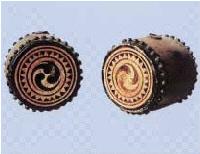
Four drums were offered to the Ota Shrine from the Oshu Nakamura feudal lord Tomotane in 1872, along with a feathered spear. However, two of the drums were damaged, and so they cannot be played.
The frames of the drums were made from Japanese zelkova tree wood. War drums used to be used in battle to heighten the warriors’ fervor, or to signal advance or retreat. Drums to press the attack, drums to indicate the start of the battle, and other types of war drums, along with signaling conches, were absolutely necessary on the battlefield.
In 1665, the Oshu Nakamura feudal lord Tadatane called on the Takeda-style tactician Ooe Matazaemon and gunman Seki Hachizaemon for assistance, and adopted the Takeda-style war tactics through a wild horse chasing drill. He spread out 10 groups of warriors to practice adapting to one’s immediate circumstance.
In 1958, the Ota Shrine had the opportunity to commission a drum repair job by the taiko drum master Miyamoto Unosuke. During repairs, the date the drums were made, 1691, was found inscribed on the inside of the drum frame, making them a precious historical property.
15. Hirafuku Suian Hitsu No Shinmezu Ema (Sacred Votive Horse Image by Artist Hirafuku Suian)
Type: City Designated Tangible Cultural Property (painting)
Date Designated: August 29, 1967
Location: Minamisoma Museum – Haramachi, Gorai, Deguchi 194
Google Maps: Minamisoma Museum
Owner: Soma Ota Shrine
Dimensions: Height – 62.5 cm Length – 85.7 cm
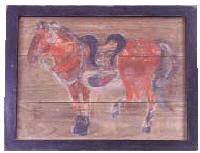
This votive image, or an image offered in fulfilment of a vow, was presented to the Soma Ota Shrine. The sacred horse on the plank was drawn in red and dressed in a saddle, stirrups, and other horse gear. Its front legs are standing still, but its back right leg is slightly raised as though pawing at the ground, giving the image a realistic feeling.
The person who dedicated the image, known as Ebata, lived in Senbokugun Sennanmura in Akita Prefecture, and offered the image in a prayer for the safety of their workhorse during farmwork. Soma Ota Shrine is one of the three Myouken Shrines of Soma Nomaoi, and many in the Tohoku region and even up into Hokkaido believe it to house a god of horse protection. People from all over gather at the shrine during the spring and summer festivals, as well as during Nomaoi.
The artist, Hirafuku Suian (1844-1890) was a painter from the Maruyama Shijou school of painting, born in Kakunodate Village in Akita Prefecture. After he studied in the imperial capitol, he became active in his home area. His son was Hirafuku Hyakusui, a very famous painter.
16. Torigeyari (Feathered Spear)
Type: City designated tangible folk cultural property
Date Designated: August 29, 1967
Location: Minamisoma Museum – Haramachi, Gorai, Deguchi 194
Google Maps: Minamisoma Museum
Owner: Soma Ota Shrine
Dimensions: Large – 240 cm Small – 210 cm
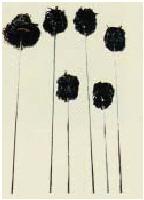
Dedicated to the Ota Shrine by the Oshu Nakamura feudal lord Tomotane in 1872.
The head house of the Soma clan, the Chiba family, worshiped the Buddhist guardian deity Myouken (due to Shinto-Buddhist syncretism, which was Japan’s only organized religion up until the Meiji period). Under the leadership of Soma Shigetane, the Soma clan moved from the Soma district in Soshu (an area centered around modern-day Toride City and spreading over Ibaraki and Chiba Prefectures) to Ota Village in the Namekata district of Oshu (modern-day Minamisoma area). They carried the deity Myouken with them when they moved, which has continued to be the guardian deity of the family of the household throughout the years. The first structure Shigetane built is said to be in the location of the current Soma Ota Shrine.
The torigeyari is a traditional item used during the Nomaoi procession. The feathered plumes are used to represent a district’s social standing. There are large and small feathered spears, and black feathers cover the top of the spear’s long handle. They used to be used in battle, but from the Edo period onwards they were solely used in processions such as the Nomaoi parade or the daimyo’s official attendance service in Edo as a symbol of authority.
There is one large feathered spear and five small feathered spears in the museum’s possession. From a social standing point of view, the large spear represents 10,000 koku (roughly 18 million liters of rice), while each of the small spears represents 1,000 koku (roughly 1.8 million liters of rice).
17. Fujitake Shozou Monjo (Record of the Fujita Clan’s Possessions)
Type: City designated tangible cultural property (ancient document)
Date Designated: August 29, 1967
Location: Minamisoma City
Owner: Individual
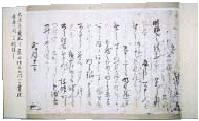
The Fujita clan record consolidates three scrolls of archives transmitted to the Fujita family. With a total of 41 documents, there are 29 notes of itemizations, as well as 5 fragments of documents. The rest are documents on duties, petitions, government papers, and renga (an early form of Japanese poetry).
The Fujita clan came from Harechika, the second son of Date Hisamune’s younger brother Yoshimune, the steward of Kakeda Castle. The clan looked after the Fujita house in the Date district. Toward the end of the Tenbun era (mid-16th century), Date Harumune and his son Terumune were attacked at Kakeda Castle, and the castle fell. Harechika turned to the elder sister of Soma Moritane’s wife for aid and became a vassal, serving the Soma Clan for generations.
Amongst the historical records, Date Muneshige lost his life at Sakai residence in Edo due to a sword wound from Harada Munesuke (a.k.a. Harada Kai). This incident led to the Date Disturbance in the Kanbun period in 1671. Date Muneshige’s body was left on the Hamakaidou Road that runs along the coast. It is said that when the Soma Clan passed through that area, five warriors in attendance stopped where he lay to bow in respect.
The writer who consolidated these records was Fujita Hajime, an artist skilled with the brush and the author of “Soma Nomaoi Shoukou” (“Some Thoughts on Soma Nomaoi”).
18. Ryuu to Karajishi (The Dragon and the Lion)
Type: City designated tangible cultural property (handicraft)
Date Designated: November 12, 1970
Location: Mishima Shrine – Haramachi, Motomachi 1-chome
Google Maps: Mishima Shrine
Owner: Mishima Shrine
Dimensions:
Dragon: Length – 2.5 meters Height – 0.45 meters
Lion: Length – 0.32 meters Width – 0.48 meters
Height – 0.35 meters
“The Dragon and the Lion” are stored in the treasure house at Mishima Shrine. It is a carving on the former front shrine, decorating the front of the shrine’s roof beam jutting from the sides of the roof pillars above the shrine’s steps. The dragon was carved from a single piece of uncolored finished Japanese zelkova wood. The three-dimensionality of the shapes and the feeling of motion overflowing from the spirals makes this a spectacular work of art.
The lion is also made from a single piece of uncolored finished Japanese zelkova wood, with the whole body covered in curled fur. There are hints of coloring in the gold eyes, the red mouth, and the white teeth. The lion is thought to have been created by Okuma Tatsumune of the Nakatomi Shinto priestly family, while the dragon is thought to be the creation of Shoumune Tatsu of the Uesugi house.
The Niitate clan, which was given the territories of South Niida, North Niida, and Sakurai by the Soma clan which worshiped the god Oyama Tsumi, ceremonially imbued a part of the deity into the Mishima Shrine.
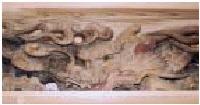
Dragon

Lion
19. Nomaoi Zu Byoubu (Folding Screen with Illustration of Chasing Wild Horses)
Type: City designated tangible cultural property (painting)
Date Designated: November 12, 1970
Location: Haramachi, Motomachi 1-chome
Owner: Individual
Dimensions: Height – 1.46 meters Length – 2.35 meters
The folding screen is made of a smooth, strong type of paper known as torinokogami. Entering into the illustration of Nomaoi through the Haramachi wicket gate (current-day Yotsuba intersection) on the left side, we see the depictions of a line of booths, a show tent flying a banner, and strung-up curtains, displaying the prosperity of that time period. We also see military headquarters in the distance, flying a small banner, painted in the upper area of the illustration. This shows a masterful depiction of visual perspective and depth.
In the lower left side is a slightly elevated hill (Yonomori), upon which several pine trees grow. Under the trees, a countless mass of people gather to enjoy the spectacle of Nomaoi. Numerous formations of troops bristling with banners and flags are depictedin the upper area of the image, showing the enormous scale of Nomaoi.
In the lower left of the folding screen, there is writing in the margins reading “The 39th of the Sexagenary Cycle (on the Chinese calendar), a Summer Day, Senju Hiroshi” with the seal reading “Chihiro.” It is thought that this folding screen was made in the late Edo period, and using the Chinese calendar, this points to the summer of 1842. The creator is thought to be Senju Hiroshi, a painter in the Musashi Province of Edo.
Looking into the details, this is an interesting and raw portrayal of Nomaoi that gives us a glimpse into the daily lives of ordinary people.
Note: For the sake of preservation, the folding screen is not available for public viewing.
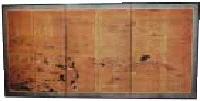

Depiction of Yonomori hill
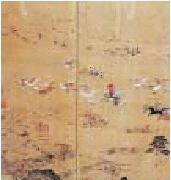
Depiction of the horse chase
20. Hayamadake no Kido Ato (Site of Wicket Gate on Hayama Peak)
Type: City designated historic site
Date Designated: July 1, 1972
Location: Harmachi, Kamiota, Niibashi
Owner: Individual

Due to the increasing number of wild horses grazing in the Nomaoi field and laying waste to the surrounding crops, Soma Tadataneko spent 3 years constructing an embankment around the field, starting in 1666.
Wicket gates acted as ways in and out of the field, and gatekeepers were assigned at heavily-trafficked locations to manage the horses as well as the comings and goings of people. The site of the wicket gate on Hayama Peak was the chief entrance on the southern side of the Nomaoi field, connected to the Hamakaidou road.
The other sites of gates in the wild horse embankment include the Hamaeba Gate, the Upper Baba Gate, the Lower Baba Gate, the Okido Gate, the Haramachi Gate, the Sakurai Gate, the Kaibama Gate, the Sukakeba Gate, the Ichikokuzaka Gate, the City Crossing Gate, and the Waterfall Gate.
21. Izumi no Tate Ato (Site of Izumi Mansion)
Type: City designated historic site
Date Designated: June 1, 1973
Location: Haramachi, Izumi, Tatemae
Owner: Tohoku Electric Co., Ltd.
Dimensions: Core of the site – 100 meters x 40 meters
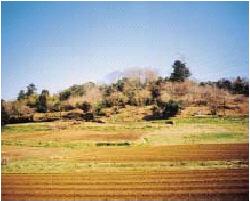
The Izumi Mansion site is on a hill to the north of the Tohoku Electric General Technology Training Center. It was the site of a mountain castle from the Middle Ages that used the natural terrain for construction. It is said to have been the residence of the Izumi clan, which descended from the Soma clan.
In around 1323, Izumi-kunaitayuu Taneyasu followed Soma Shigetane away from the capital from Shimousa toward the Namekata district (now Minamisoma area), and became the founder of the Izumi clan. During the Sengoku period, Izumi-touuemon Tanemasa received a fiefdom and possessed great power (according to the Ososhi, a book written between the end of the Edo period and the beginning of the Meiji period, containing the history and geography of the Soma area). During the construction of Ushigoe Castle in 1597, he caused a problem, and fire was set to the Izumi Mansion in a show of disapproval of Soma Yoshitane’s judgement. He fled to Aizu and became vassal to Uesugi Kagekatsu.
Afterwards, Okada Hachibei no Butane came into possession of the area lived in Tairadate in Tategoshi near the mansion until the Soma clan moved to Nakamura Castle in 1611.
Izumi Mansion is counted as an important piece of history, showing the deep connection between the Soma family and the Izumi clan during the Middle Ages. It is counted as an important historic ruin among all the mansion sites within the Soma area.
- この記事に関するお問い合わせ先
- このページに関するアンケート
-
より良いウェブサイトにするために、このページのご感想をお聞かせください。















更新日:2021年04月21日